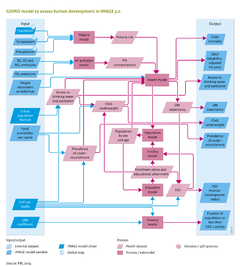Human development/Policy issues: Difference between revisions
Jump to navigation
Jump to search
No edit summary |
No edit summary |
||
| Line 11: | Line 11: | ||
# improving the quality of access through, for example, household connections to the drinking-water supply and LPG or kerosene instead of using improved biomass stoves; | # improving the quality of access through, for example, household connections to the drinking-water supply and LPG or kerosene instead of using improved biomass stoves; | ||
# improving behaviour through female education, hygiene measures and good ventilation; | # improving behaviour through female education, hygiene measures and good ventilation; | ||
# mitigating environmental changes, such as climate change, biodiversity loss and water stress | # mitigating environmental changes, such as climate change, biodiversity loss and water stress. | ||
The | The GISMO model addresses the first three options, whereas the last option is addressed in other parts of the IMAGE framework. | ||
The figure on the left presents the results from two policy scenarios in addition to the baseline scenario (see also [[PBL, 2012]]). The first scenario (Global Technology Pathway) addresses improving access to food, water and energy: | |||
* By 2030, all people will have access to modern energy sources or at least will use improved biomass stoves for cooking | * By 2030, all people will have access to modern energy sources or at least will use improved biomass stoves for cooking | ||
* By 2050, hunger will be eradicated | * By 2050, hunger will be eradicated | ||
Revision as of 13:38, 9 December 2013
Parts of Human development/Policy issues
| Component is implemented in: |
|
| Related IMAGE components |
| Projects/Applications |
| Models/Databases |
| Key publications |
| References |
